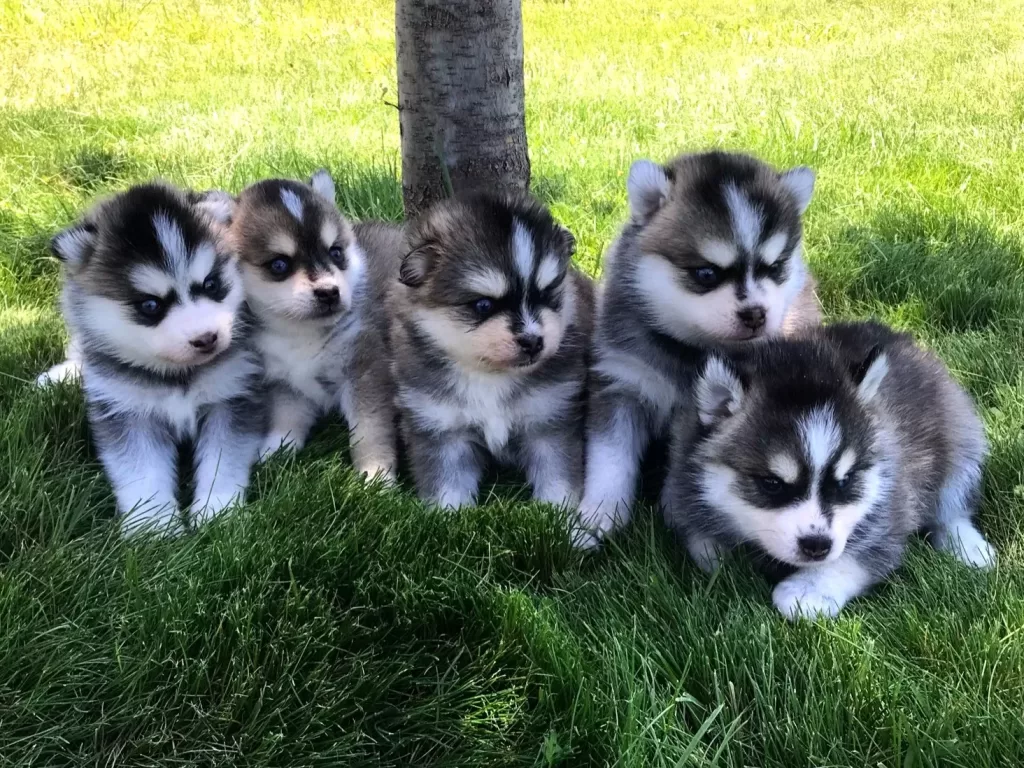As a proud German Shepherd owner, I’ve always been fascinated by unique dog breeds. When my niece expressed interest in getting a smaller companion, I discovered the enchanting world of Teacup Pomskies – a designer breed that captures hearts with their miniature size and striking appearance.
The Teacup Pomsky results from a carefully planned breeding program between a Pomeranian and a Siberian Husky through artificial insemination. These pint-sized pups come in two main genetic compositions:
- 37.5/62.5 ratio (37.5% Siberian Husky)
- 50/50 ratio (50% Siberian Husky)
This comprehensive guide shares my research findings about these adorable Mini Husky Pomeranian mixes. You’ll learn about their distinctive characteristics, care requirements, and what makes them unique companions. Whether you’re considering adding a Teacup Pomsky to your family or simply curious about this remarkable breed, this article provides essential information to understand these captivating designer dogs.
Table of Contents
Understanding Teacup Pomskies
As a German Shepherd owner exploring designer breeds, I’ve discovered fascinating details about Teacup Pomskies. These miniature marvels represent a specialized variation of the standard Pomsky breed, created through selective breeding of Pomeranians and Siberian Huskies.
Genetic Makeup of Teacup Pomskies
The genetic makeup of Teacup Pomskies typically follows a 75/25 ratio – meaning they’re:
- 75% Siberian Husky genes
- 25% Pomeranian genes
This specific genetic blend creates what breeders call “Platinum Pomskies,” known for their:
- Compact size
- Enhanced agility
- Distinctive facial features
- Balanced temperament
Inherited Traits from Parent Breeds
Mixed breed dogs like Teacup Pomskies inherit traits from both parent breeds. Understanding these genetic combinations helps predict:
- Physical characteristics
- Behavioral patterns
- Health predispositions
- Care requirements
Distinctive Features of Teacup Pomskies
The unique blend of Husky and Pomeranian genes creates distinctive features in Teacup Pomskies:
- Wolf-like appearance from their Husky ancestry
- Compact size from their Pomeranian genes
- Thick double coat inherited from both parents
- Expressive facial features combining both breeds’ characteristics
This genetic diversity makes each Teacup Pomsky truly unique, with varying combinations of their parent breeds’ traits appearing in different proportions.
1. Unique Characteristics and Appearance
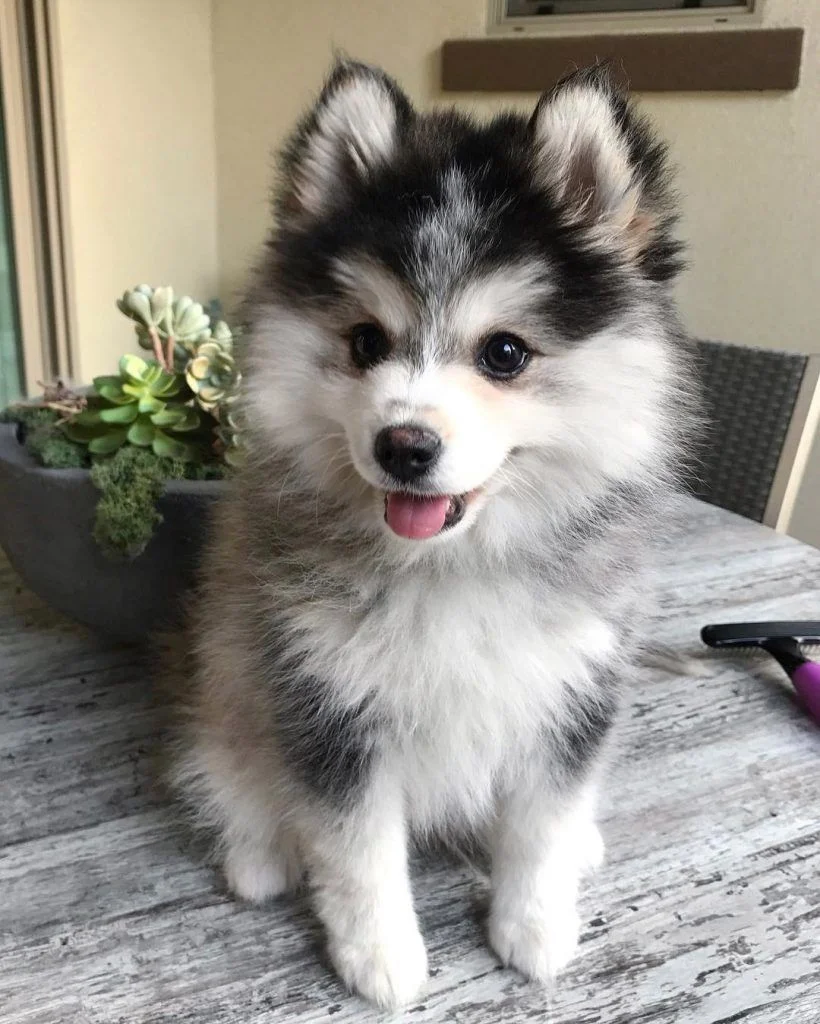
My Rocky’s majestic appearance always turns heads at the park, but these tiny Teacup Pomskies steal the spotlight with their enchanting looks. Their distinctive features create an irresistible blend of their parent breeds’ best traits.
Facial Features
The facial features of Teacup Pomskies showcase a perfect mix:
- A petite, fox-like face inherited from Pomeranians
- The signature “mask” markings of Huskies
- Small, pointed ears that stand erect
- A compact, button nose
Coat
Their coat is a masterpiece of nature, featuring:
- Dense, double-layered fur that’s incredibly soft
- A plush texture similar to a stuffed animal
- Various stunning patterns including:
- Classic merle with marbled effects
- Rich red tones
- Creamy white
- Deep orange hues
- Subtle lavender shades
- Traditional black and white combinations
Eyes
One of the most captivating features is their eyes. During my research, I discovered these little beauties can have:
- Striking blue eyes like Huskies
- Warm brown tones
- Rich hazel colors
- Heterochromia – different colored eyes in the same dog
Tail
Their tail adds the finishing touch – typically curled over their back, displaying a fluffy plume that waves like a banner when they’re excited. The combination of these features in such a compact package makes Teacup Pomskies truly unique in the designer dog world.
2. Size Variations in Teacup Pomskies
As a proud German Shepherd owner, I was amazed to discover just how tiny these adorable Teacup Pomskies are. My Rocky could practically fit three of them under his chin!
A full-grown Teacup Pomsky typically reaches:
- Height: 10 inches at the shoulder
- Weight: 7 pounds (ranging from 4-9 pounds)
These measurements create a stark contrast with standard Pomskies, which can reach:
- Height: 15-17 inches
- Weight: 20-30 pounds
The size difference stems from selective breeding practices using smaller Pomeranians and Huskies. My niece was particularly drawn to their compact size, making them perfect for apartment living. Their petite stature allows them to curl up comfortably in small spaces, though they still maintain that distinctive wolf-like appearance of their Husky parentage.
Note: Size variations can occur based on genetic factors and which parent breed’s traits are more dominant.
3. Historical Background of Pomskies
As a German Shepherd owner fascinated by designer breeds, I discovered the captivating origin story of Pomskies during my research. The breed’s journey began in 2009 in Arizona, where dedicated breeders successfully created the first Pomsky through artificial insemination – a groundbreaking achievement in designer dog breeding.
The initial breeding program aimed to combine the striking appearance of a Siberian Husky with the compact size of a Pomeranian. This innovative approach sparked interest among dog enthusiasts and breeders nationwide.
The breed’s popularity skyrocketed between 2011-2015, leading to:
- Creation of the Pomsky Club of America (PCA)
- Establishment of breeding standards
- Development of specialized breeding programs
Social media played a pivotal role in the breed’s rise to fame. Photos of these adorable puppies went viral, creating unprecedented demand. By 2017, waiting lists for Pomsky puppies extended several months, with some prospective owners willing to travel across states to secure their companion.
The Teacup Pomsky variant emerged as breeders refined their techniques to produce even smaller specimens. This specialized breeding focused on selecting the most petite Pomeranians and smaller Huskies to achieve the desired miniature size while maintaining the breed’s distinctive features.
4. Temperament and Personality Traits
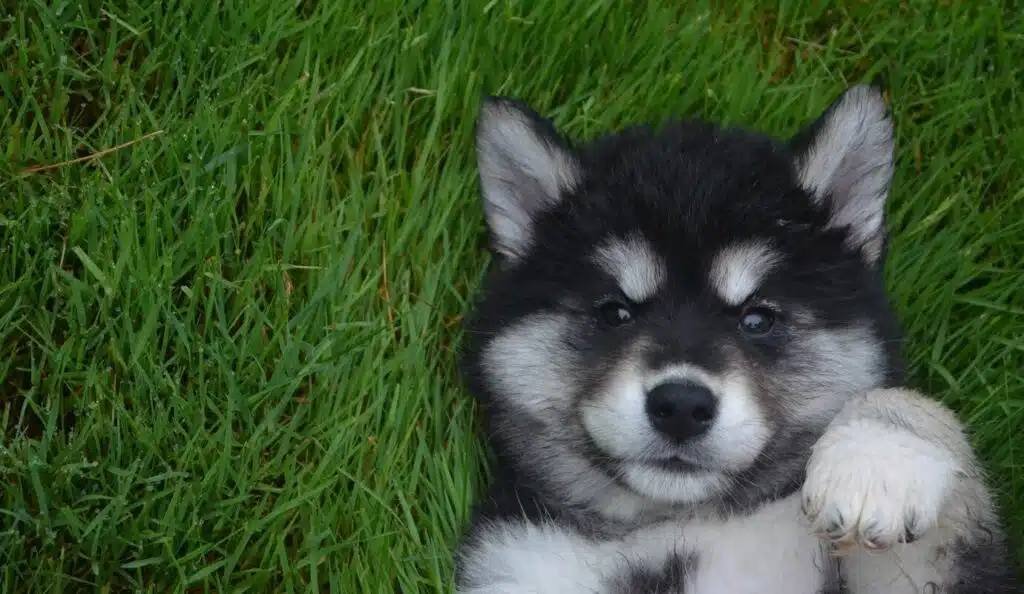
As a proud German Shepherd owner, I’m fascinated by the unique personality blend of Teacup Pomskies. These tiny powerhouses pack a remarkable combination of traits from both parent breeds.
The social butterflies of the designer dog world, Teacup Pomskies display:
- Boundless affection towards family members
- Natural protective instincts without aggression
- Playful and energetic disposition
- Strong bonds with their primary caregiver
Their vocal nature shines through with:
- Gentle howling (Husky heritage)
- Occasional yapping (Pomeranian influence)
- Alert barking when sensing unfamiliar presence
These pint-sized companions demonstrate surprising adaptability in various social settings. My niece would love how they interact confidently with strangers while maintaining a watchful eye over their loved ones. Their non-aggressive protective nature makes them ideal apartment dogs, though their delicate size requires careful handling.
The Teacup Pomsky’s intelligence creates an engaging personality that keeps you on your toes – much like my Rocky, they’re always ready for the next adventure or cuddle session.
5. Exercise Requirements for Teacup Pomskies
My German Shepherd Rocky needs plenty of exercise, but I’ve discovered that Teacup Pomskies have different activity requirements. These adorable mini Husky Pomeranian mixes need 30-45 minutes of daily physical activity, split into:
- Two 15-20 minute walks
- Interactive play sessions with toys
- Mental stimulation games
Despite their small size, Teacup Pomskies inherit the energetic traits of both parent breeds. A proper exercise routine includes:
- Morning Walk: A brisk walk to start the day
- Afternoon Activities:
- Fetch games
- Tug-of-war
- Puzzle toys
- Evening Walk: A gentle stroll before bedtime
Indoor exercise options work well for these compact dogs:
- Hide-and-seek games
- Obstacle courses
- Training sessions
Regular exercise prevents behavioral issues like excessive barking or destructive chewing. Their small stature means they can get adequate exercise in limited spaces, making them suitable for apartment living.
6. Grooming Needs and Shedding Tendencies
As a German Shepherd owner, I was surprised to discover that Teacup Pomskies demand even more grooming attention than my Rocky. These tiny pups inherit a thick double coat that requires dedicated maintenance:
Daily Grooming Requirements:
- Brush through the coat for 15-20 minutes
- Use a pin brush followed by a slicker brush
- Pay special attention to behind ears and leg areas
- Remove loose undercoat with a de-matting tool
Seasonal Shedding Patterns:
- Spring: Heavy shedding as winter coat falls out
- Fall: Moderate shedding while preparing winter coat
- Year-round: Regular light shedding
The bathing schedule depends on your Teacup Pomsky’s activity level. My research shows most owners settle into a rhythm of bathing every 6-8 weeks. Use a gentle dog shampoo and ensure thorough drying – their thick coat can trap moisture and cause skin issues.
Pro Tip: Keep a grooming calendar to track brushing sessions and bath times. I’ve learned from Rocky that consistency is key to maintaining a healthy coat.
7. Feeding Guidelines for Teacup Pomskies
My Rocky’s appetite has taught me that proper nutrition is crucial for any dog, but Teacup Pomskies need special attention due to their small size. These tiny pups require a protein-rich diet to maintain their energetic nature and support their thick double coat.
Here’s what your Teacup Pomsky’s diet should include:
- High-Quality Protein (25-30% of diet): Chicken, fish, or lamb as primary ingredients; essential for muscle maintenance and growth
- Healthy Fats (15-20% of diet): Omega-3 and Omega-6 fatty acids; supports coat health and brain function
- Complex Carbohydrates (Limited amounts): Sweet potatoes, brown rice; provides sustained energy
The feeding schedule depends on age:
- Puppies: 3-4 small meals daily
- Adults: 2 measured portions daily
A typical adult Teacup Pomsky needs 1/2 to 3/4 cup of food per day, split into two meals. Always keep fresh water available and monitor their weight to adjust portions as needed.
8. Common Health Concerns in Teacup Pomskies
As a dog parent, I’ve learned that Teacup Pomskies inherit health predispositions from both parent breeds. These tiny companions typically enjoy a lifespan of 13-15 years with proper care.
Common Health Issues:
- Skin allergies and infections
- Heart disease
- Collapsing trachea
- Epilepsy
- Patellar luxation
- Dental problems
- Common health problems in small breed dogs
My Rocky’s vet emphasizes regular health screenings for early detection. I’ve noticed Teacup Pomskies can be sensitive to extreme temperatures due to their small size. Their delicate bone structure requires careful handling to prevent injuries.
Prevention Tips:
- Schedule bi-annual vet check-ups
- Monitor skin conditions closely
- Maintain dental hygiene
- Keep up with vaccinations
- Watch for signs of joint problems
The breed’s small size makes them susceptible to hypoglycemia, particularly during puppyhood. A balanced diet, regular exercise, and proper medical care help minimize these health risks. Genetic testing through reputable breeders can screen for inherited conditions.
9. Socialization and Training Tips for Teacup Pomskies
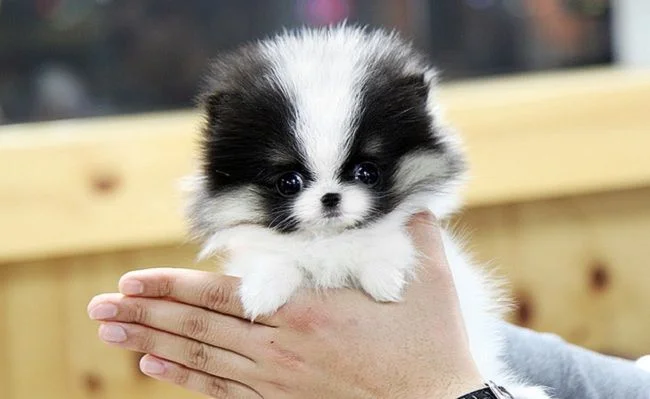
My Rocky’s training experience taught me that intelligence can be a double-edged sword – the same applies to Teacup Pomskies. These little bundles of joy inherit sharp minds from both parent breeds, making them quick learners but also quite stubborn at times.
Essential Training Tips:
- Start training sessions as early as 8 weeks old
- Keep sessions short (5-10 minutes)
- Use positive reinforcement with treats and praise
- Maintain consistency in commands and rules
- Practice patience – rushing leads to resistance
Socialization Checklist:
- Introduce to different people and pets
- Expose to various environments and sounds
- Visit dog parks during quiet hours
- Arrange supervised playdates
- Practice gentle handling and touching
I’ve noticed that harsh corrections or raised voices can make these sensitive pups shut down completely. The key lies in gentle guidance and creating positive associations. Their size might be tiny, but their need for proper socialization matches that of larger breeds – skipping this crucial step often leads to anxiety and behavioral issues later.
Remember to reward calm behavior and establish clear boundaries. These intelligent pups excel with puzzle toys and mental stimulation exercises alongside their physical training routines.
10. Creating a Safe Living Environment for Your Teacup Pomsky
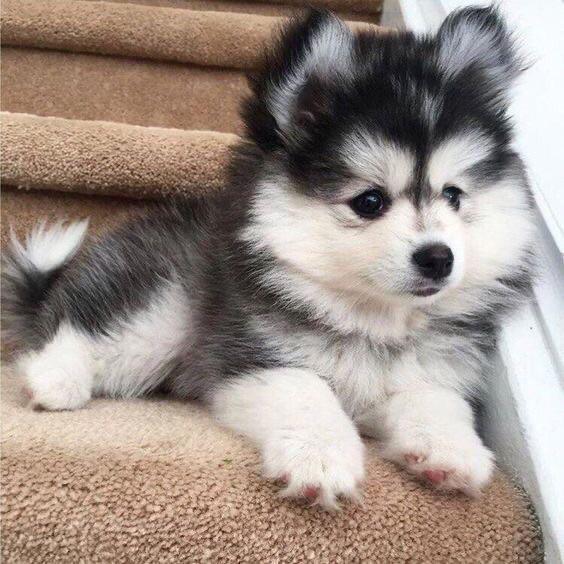
As a proud German Shepherd owner, I understand the importance of pet-proofing – it’s even more crucial for tiny Teacup Pomskies. These miniature pups need specific home modifications to thrive safely.
Essential Safety Measures:
- Install baby gates at stairs and restricted areas
- Cover electrical outlets and secure loose wires
- Remove toxic houseplants (lilies, tulips, azaleas)
- Store cleaning supplies in locked cabinets
- Use raised food/water bowls to prevent neck strain
- Place non-slip mats in bathing areas
Indoor Comfort Setup:
- Create a cozy den with a size-appropriate bed
- Position furniture to prevent jumping from heights
- Maintain moderate room temperature (68-72°F)
- Set up a designated potty area
- Keep small objects out of reach
My experience with Rocky taught me to check floor-level hazards regularly. For Teacup Pomskies, their diminutive size makes them vulnerable to getting stuck in small spaces or injured by items we might overlook. A thorough daily scan of their environment helps prevent accidents and ensures these delicate pups stay safe.
Cost of Ownership: What to Expect When Owning a Teacup Pomsky
As a proud German Shepherd owner, I was surprised to discover that Teacup Pomskies come with significant financial responsibilities. The initial purchase price for first-generation Pomsky puppies ranges from $2,000 to $5,000, depending on the breeder’s reputation and the puppy’s characteristics.
Here’s a breakdown of essential recurring costs:
Monthly Expenses:
- Premium dog food: $40-60
- Grooming supplies: $30-50
- Pet insurance: $30-70
- Toys and treats: $20-40
Annual Expenses:
- Veterinary check-ups: $200-400
- Vaccinations: $100-200
- Professional grooming: $300-600
- License and registration: $20-50
One-Time Costs:
- Microchipping: $45-55
- Spaying/neutering: $200-500
- Initial supplies (bed, crate, bowls): $200-300
- Training classes: $150-300
My research shows that the first year of Teacup Pomsky ownership typically costs between $4,000-7,000, including the purchase price. Subsequent years average $1,500-2,500 in maintenance costs. These expenses reflect the breed’s need for high-quality nutrition, regular grooming, and preventive healthcare to maintain their distinctive appearance and vibrant personality.
Finding a Reputable Breeder or Consider Adoption
As a proud German Shepherd owner, I’ve learned the importance of responsible breeding practices. When searching for a Teacup Pomsky, identifying reputable breeders requires careful consideration.
Key Questions for Potential Breeders:
- Health testing documentation for both parent breeds
- Vaccination and deworming records
- Living conditions of breeding dogs and puppies
- Written health guarantee and contract
- References from previous customers
- Breeding experience and certifications
Red Flags to Watch For:
- Significantly lower prices than market average
- Reluctance to show breeding facilities
- Limited health information
- Pressure to make immediate decisions
- Multiple litters available simultaneously
Benefits of Adoption:
- Give a deserving dog a second chance
- Lower initial costs
- Adult dogs with established personalities
- Support rescue organizations
- Reduced risk of puppy mill support
Finding Rescue Organizations:
- Local small breed rescue groups
- Pomeranian and Husky specific rescues
- Online adoption platforms
- Social media rescue networks
- Breed-specific forums
Remember, whether choosing a breeder or adoption, prioritize organizations that demonstrate commitment to animal welfare through thorough health screenings and transparent practices. My experience with Rocky taught me that responsible sourcing creates lasting, healthy relationships between dogs and their families.
FAQs (Frequently Asked Questions)
What are the unique characteristics of Teacup Pomskies?
Teacup Pomskies are known for their distinct appearance, which includes a variety of coat colors such as merle, red, and cream, as well as diverse eye colors including brown, hazel, and blue. Their mixed breed background contributes to their unique traits.
What is the typical size and weight of a Teacup Pomsky?
Teacup Pomskies typically weigh around 7 pounds and stand about 10 inches tall. They are smaller compared to standard Pomskies, making them a popular choice for those seeking a miniaturized version of the breed.
What kind of exercise do Teacup Pomskies require?
Teacup Pomskies need regular daily exercise to maintain their health. Recommended routines include short walks and playtime that accommodate their energy levels while ensuring they do not overexert themselves due to their small size.
How often should I groom my Teacup Pomsky?
Daily brushing is essential to prevent mats and tangles in your Teacup Pomsky’s fur. Additionally, bathing should be done every one to three months, with shedding tendencies varying throughout the seasons.
How can I find a reputable breeder or consider adopting a Teacup Pomsky?
To find a reputable breeder, look for responsible breeding practices and ask questions about the puppy’s lineage. It’s also beneficial to consider adoption through rescue organizations that specialize in small breeds, which can provide loving homes for dogs in need.

